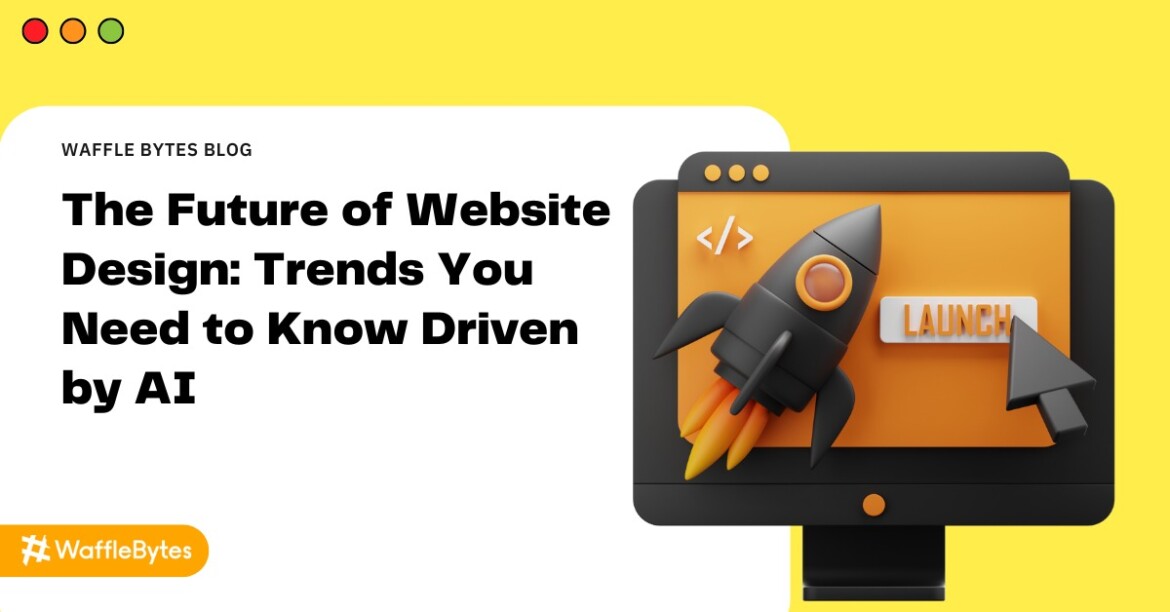Artificial intelligence (AI) is making the digital world a different world with how one builds, develops, and interacts with web pages. As 2025 approaches, science fiction AI is no longer sci-fi, but an element of the intrinsic web in how it’s used to make a vibrant user-focused web, not to mention its potential to help push creativity further. This paper outlines some core trends marking that evolution and the implications of all this for the future of web design.
1. Hyper-personalized user experiences
AI allows websites to work based on an understanding of user behavior, preferences, and historical data analysis and provides content in real-time. This makes it possible to have:
- Dynamic Content Adjustments: Layouts, product recommendations, and color schemes change according to user behavior, and every user has a unique journey.
- Behavior-Driven Personalization: E-commerce websites use browsing history to display appropriate products, while media websites showcase articles or videos based on a user’s interests.
- Predictive Personalization: Machine learning can predict what users need, for example, by auto-filling forms or providing services before they are requested.
This move from static, one-size-fits-all designs to fluid, adaptive interfaces ensures more engagement and higher conversion rates.
2. AI-Driven Automation in Design Processes
AI applications automate time-consuming tasks:
- Automated Layout Generation: Algorithms create usable, aesthetically pleasing templates based on brand guidelines and content requirements, thus reducing manual coding.
- Rapid Prototyping: Designers input parameters such as target audience or industry, and AI generates a variety of design options for further refinement.
- Content Creation: NLP crafts SEO-friendly copy, while AI image generators produce custom visuals aligned with brand aesthetics.
These tools democratize web design, enabling businesses to have professional sites without requiring deep technical knowledge.
3. Intelligent chatbots and virtual assistants
Next-gen chatbots above query resolution:
- Contextual Understanding: Bots can process complex conversations, resolve complaints, and guide users through multi-step processes.
- Proactive Engagement: Bots analyze user behavior to offer timely suggestions, like discounts on abandoned cart items or onboarding tips for new users.
- 24/7 Multilingual Support: Instant responses in the user’s preferred language add to the level of accessibility and customer satisfaction.
Chatbots, by 2025, are going to seem less transactional and more intuitive digital assistants.
4. Immersive 3D and AR/VR Integration
Sites are adopting spatial design for high interactivity.
- 3D Product Visualizations: Users can zoom, rotate, or customize furniture items, clothes, etc. in real-time to minimize the difference between the online experience and offline experiences.
- Virtual Showrooms: AR enables users to “place” products in their physical environment through smartphone cameras, which boosts confidence in purchases.
- Gamified Interfaces: Interactive 3D elements and scroll-triggered animations make browsing feel like an exploratory journey.
These technologies reduce decision fatigue while increasing dwell time and conversion rates.
5. Voice-Activated Navigation
Voice search optimization is becoming critical:
- Hands-Free Navigation: Customers choose options, search for products, or make purchases by voice commands while multi-tasking or for those who have impaired abilities.
- Interactive AI: Online applications include speech-enabled assistants with natural language comprehension, e.g., asking the platform to display blue shirts that cost under $50.
- SEO Keyword Optimization: Products are optimized based on long-tail, conversational keywords aligned with voice searches.
This is also in line with the increasing number of smart speakers and voice-enabled devices’ dominance.
6. Sustainable and Ethical Design Practices
Eco-friendly considerations inform both style and functionality:
- Minimalist Design: A simple layout with plenty of white space helps reduce cognitive load and energy use.
- Dark Mode Defaults: Brightness levels are lower, helping to save the battery life of the device, especially on OLED screens.
- Efficient Coding: AI tools will optimize codebases and compress media files to help reduce carbon footprint.
Ethical AI practices, such as transparent use of data and mitigating biases, are also a priority in creating user trust.
7. AI-Improved SEO and Accessibility
AI optimizes websites for search rankings and better audience engagement:
- Automated SEO Audits: Tools identify broken links, duplicated content, or slow load times and give remedies.
- Alt-Text Generation: Image recognition AI creates the best description of an image so screen readers can have access.
- Predictive Analytics: Algorithms predict keyword trends and user intent so you can pre-empt content moves.
Strictly.ai cutting-edge SEO tools are ensuring visibility in AI-driven search engines and improving overall web accessibility.
8. Real-Time Adaptation and Predictive UX
Websites evolve dynamically based on user interactions:
- Behavior-Triggered Changes: If a user hesitates on a pricing page, the site might instantly display testimonials or a chatbot offer.
- A/B Testing at Scale: AI conducts concurrent experiments on layouts, CTAs, or images and implements the best-performing ones on its own.
- Emotion Recognition: New technologies scan facial expressions through webcam or typing patterns to adjust the tone of content.
This responsiveness lends the interface an intuitive, “life-like” quality.
The Road Ahead: Emerging Trends for 2025+
- Generative Design: AI will create new design elements logos to based on brand DNA and user preferences.
- Neural Interface Integration: BCIs would help navigate through the use of the mind, which redefined accessibility.
- Decentralized AI: Blockchain-integrated AI might have hosted web experiences personalized on secure, user-controlled nodes.
Conclusion
AI is augmenting human creativity not replacing it. Automated repetitive tasks, data-driven insights, and design will be focused on innovation: making emotionally resonant, ethically grounded experiences. As VR, voice interfaces and predictive personalization mature websites in 2025 will be the most intuitive, inclusive,and immersive ever. Companies that get AI will lead in engagement, loyalty, and adaptability and future-proof their digital presence in a landscape that’s only getting more competitive.
This combination of AI and humans will give us a web that’s not only smarter but more human.

